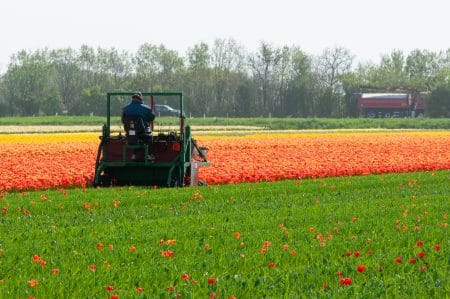You have a favorite tulip. The color is superb, and the shape and proportions fit your notion of the tulip ideal. You order it every year, and every spring drivers stop in front of the house to take pictures.
And then one summer you check the Colorblends website and your tulip is missing. You call. “I’m sorry, Ma’am, we can’t get that tulip anymore. It’s no longer grown.” No longer grown? How can that be? You want to know why tulips disappear.
Tulip Econ 101

The main reason a grower in the Netherlands drops a variety is a decline in demand. There is a market for tulips, as there is for most things, and if demand falls, so must supply. Perhaps the color has gone out of favor. Or a new variety has come along that grows better or looks better or is more compact
or taller.
Whatever the cause, when a grower finds he is planting only half a hectare of a variety, he has to consider stopping. Half a hectare is more than an acre, an area large enough to yield up to 150,000 topsize tulips. Sounds like a lot, but when you consider that each variety has its own requirements — machinery settings for planting and digging, handwork for cleaning and processing, storage temperatures, etc. — and that labor and warehouse space are expensive, you begin to understand that this number may not be enough for the grower to break even.
Disease: The Grim Reaper

Some varieties are susceptible to disease—a fungus or nematodes or a virus. Others seem to be resistant. Luck plays a role. A variety may be disease-free for years, even decades, then develop a problem.
If a disease is manageable or it doesn’t get out of hand, a grower may stick with a susceptible variety, as long as the price he gets for the healthy bulbs he is able to harvest is high enough. But if the economic equation goes negative or a healthy new variety appears on the scene, the grower will quickly move on.
Degeneration
Tulip varieties, like trees, animals and people, have a lifespan—a beginning, middle and end. Because they consist of clones (each bulb is genetically identical), tulip varieties can, in theory, continue to make new copies of themselves indefinitely. In practice, they get old and tired.

When a grower lifts his bulbs in summer, he ships the largest sizes to his customers and keeps the small bulbs as planting stock, which he replants in the fall. As the years pass, he will likely see the number of saleable bulbs begin to decline, a phenomenon known in the trade as degeneratie. Eventually, he will have to ask himself whether the time has come to start over with a new variety.
There is a way to reinvigorate an aging variety. The grower can start a new, separate stock by planting the biggest bulbs from one harvest and then for several years doing the opposite of what he normally does: discard the small bulbs and replant only the large. He then transitions production to the new stock, slowly but surely eliminating the old stock. This used to be standard procedure when degeneration set in, but few growers go to the effort today. A new variety may not perform better than the old, but it’s a gamble the grower is willing to take.


